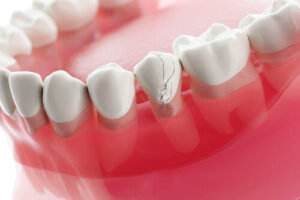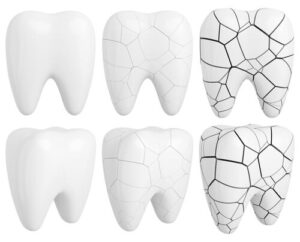Discovering a vertical hairline crack in a front tooth can be a distressing experience, often leading to concerns about dental health and aesthetics. Although these minute cracks might appear inconsequential, they can have significant implications for the integrity and future health of your tooth.
In this article, we delve into dental care to explore the causes, risks, and treatment options for a vertical hairline crack in a front tooth. Such cracks can range from benign cosmetic issues to more serious conditions that require immediate attention. As we navigate the complexities of this dental phenomenon, we will uncover how these hairline cracks occur, the symptoms to watch out for, and the latest advancements in treatment and prevention.
Understanding the nuances of such dental fractures is key to maintaining not just the health of a single tooth but overall oral wellness. Stay with us as we unravel the mysteries behind vertical hairline cracks in front teeth, providing insights into this common yet often overlooked dental concern.
What causes vertical teeth craze lines
Vertical craze lines in teeth, particularly noticeable in front teeth, are a common occurrence that can raise concerns about oral health. These fine hairline cracks in the tooth enamel often appear over time and can be a cosmetic concern.
While typically, a craze line is not a sign of severe dental issues, understanding what causes these vertical lines is crucial for maintaining good oral health and addressing any underlying issues that may contribute to their development.
What Causes Vertical Teeth Craze Lines:
- Age-Related Wear and Tear: As teeth age, they naturally undergo wear and tear, leading to the formation of craze lines.
- Teeth Grinding (Bruxism): Habitual grinding or clenching of teeth, often due to stress or sleep disorders, can put excess pressure on teeth, causing craze lines.
- Chewing Hard Foods: Regularly chewing on hard foods or objects, such as ice or hard candies, can contribute to developing these lines.
- Nail Biting: This habit can apply unusual pressure on the teeth, leading to craze lines, especially in the front teeth.
- Trauma or Injury: A blow to the mouth or an accident involving the face can result in craze lines due to the impact on the teeth.
- Temperature Extremes: Exposing teeth to extreme temperature changes, such as consuming very hot drinks followed by cold foods, can cause tiny expansions and contractions in the enamel, leading to craze lines.
- Teeth Whitening Treatments: Some over-the-counter whitening treatments can make existing craze lines more noticeable, although they don’t typically cause the lines themselves.
Craze lines are usually superficial and require no treatment, but they can sometimes be a cosmetic concern. If you notice these visible craze lines, and they bother you, or if you’re concerned they may indicate a deeper problem, consulting with a dentist can provide peace of mind and guidance. In many cases, simple measures like reducing teeth grinding, avoiding hard foods, and proper dental care are sufficient to prevent the further development of craze lines.
Craze lines vs. cracked teeth
Craze lines and cracked teeth are two dental conditions that prompt concern among individuals seeking to understand their dental health. Both phenomena involve cracks in the tooth enamel but differ significantly in their nature and impact.
Craze Lines:
- Craze lines are fine cracks in the tooth enamel, considered normal and common.
- These superficial cracks, often called craze lines, may be visible on the front adult teeth and the chewing surface.
- They are generally caused by wear and tear, including normal chewing and exposure to hard foods.
- Typically, craze lines are cosmetic concerns and don’t threaten oral health.
- Multiple craze lines are common, and they may go completely unnoticed.
Cracked Teeth:
- Cracked teeth refer to more significant structural damage and can cause dental complications.
- Cracks in teeth can range from hairline fractures to deep cracks, potentially causing sharp pain or tooth sensitivity.
- Cracked teeth often result from factors like teeth grinding (bruxism), nail-biting, uneven bite, or trauma from hard objects.
- Unlike craze lines, cracked teeth may necessitate professional intervention, such as root canal therapy or the placement of porcelain veneers.
- Deep cracks in teeth can contribute to oral health issues and may require treatment to prevent further damage.
Understanding the distinction between craze lines and cracked teeth is crucial for optimal oral health. While craze lines are generally considered a normal part of wear and tear, cracked teeth pose a more serious threat of tooth decay and may lead to complications if left untreated. Seeking appropriate care and intervention is essential for addressing dental concerns and ensuring long-term oral well-being.
Types of tooth cracks

Tooth cracks come in various forms, each differing in severity and implication for oral health. Understanding the types of tooth cracks is essential, ranging from minor cosmetic concerns to serious conditions requiring immediate dental intervention. These cracks can occur for various reasons, including trauma, biting down on hard objects, or natural wear and tear over time. Recognizing the different types of cracks can aid in early detection and appropriate treatment, thus preserving the tooth’s integrity and preventing further complications.
Types of Tooth Cracks:
- Craze Lines: These are tiny cracks that affect only the outer enamel. Typically, superficial craze lines don’t cause pain and are more of a cosmetic issue.
- Fractured Cusp: This type of crack often occurs around a dental filling. It usually doesn’t affect the tooth’s pulp and is less likely to cause pain.
- Cracked Tooth: This involves a crack that extends from the tooth’s chewing surface vertically toward the root. If the crack hasn’t reached the root, the tooth can often be saved with treatment.
- Split Tooth: This is a severe form of a cracked tooth, where the crack has progressed so that the tooth is split into two distinct segments. This can sometimes require extraction.
- Vertical Root Fracture: These cracks begin in the tooth’s root and extend towards the chewing surface. Often, they show minimal symptoms until the surrounding bone and gum become infected.
- Incomplete Fracture (Hairline Crack): These are fine cracks that don’t fully traverse the entire thickness of the tooth. They might be difficult to diagnose and often don’t cause immediate symptoms.
It’s important to consult with a dentist if you suspect you have a tooth crack. Early diagnosis and treatment are crucial in saving the tooth and preventing further oral health problems. Treatment can vary from simple bonding or a dental crown to root canal therapy or even extraction, depending on the type and severity of the crack. Regular dental check-ups and good oral hygiene can help prevent the occurrence of tooth cracks.
Can a hairline crack in the front tooth be repaired?
Certainly! A hairline crack in a front tooth can often be repaired through various dental procedures. The specific treatment depends on the severity and location of the crack. Cosmetic solutions such as dental bonding or tooth-colored fillings may be effective for minor hairline cracks.
These procedures aim to restore the tooth’s appearance and prevent the crack from worsening. However, if the crack is more significant or extends into the tooth’s structure, more extensive treatments like dental veneers or crowns may be recommended to provide both aesthetic improvement and structural support.
Consulting with a dentist is crucial to determine the most appropriate course of action based on the individual’s specific situation and the extent of the hairline crack.
How do you fix a vertical crack in your front tooth?
A vertical crack in a front tooth affects your smile and can lead to more serious dental issues if left untreated. Such cracks can range from superficial craze lines to deeper fractures that extend to the root. The approach to fixing a vertical crack in a front tooth varies based on the severity and depth of the crack, as well as the overall health of the tooth. Understanding the available treatment options and their appropriateness for different types of cracks is crucial for effective restoration and prevention of further damage.
How to Fix a Vertical Crack in Your Front Tooth:
- Dental Bonding: Dental bonding can be an effective treatment for minor cracks. A tooth-colored resin is applied to the crack and hardened with a special light, bonding the material to the tooth and restoring its appearance.
- Veneers: If the crack is superficial but extensive, veneers may be recommended. These are thin shells of porcelain or composite material that cover the tooth’s front surface, improving its appearance and strength.
- Crowns: For deeper cracks, a dental crown may be necessary. This involves covering the entire tooth with a custom-made cap, providing stability and protecting it from further damage.
- Root Canal Treatment: A root canal may be required if the crack extends into the tooth’s pulp. This involves removing the damaged pulp, cleaning the tooth’s inner chambers, and sealing it to prevent infection.
- Extraction and Replacement: In cases where the tooth is severely cracked and cannot be saved, extraction followed by replacement with a dental implant, bridge, or partial denture may be the only solution.
- Regular Monitoring: Sometimes, if the crack is very small and does not cause any symptoms, your dentist might monitor it regularly without immediate treatment.
- Avoiding Further Stress: It’s also important to address any habits that may have contributed to the crack, such as teeth grinding, and avoid them in the future.
Treating a vertical crack in a front tooth requires a careful assessment by a dental professional. They can determine the best course of action based on the type and extent of the crack. Timely and appropriate treatment restores the tooth’s function and appearance and plays a crucial role in maintaining overall oral health. Remember, each crack is unique, as is its treatment – your dentist is your best guide to choosing the right treatment plan.
How to avoid hairline cracks in teeth

Hairline cracks in teeth, often subtle yet potentially problematic, concern many seeking to maintain optimal oral health. These fine fractures, typically affecting the enamel, can arise from various habits and conditions.
Preventing them involves a combination of good oral hygiene practices, lifestyle adjustments, and being mindful of certain behaviors that can put undue stress on your teeth. Understanding how to avoid these hairline enamel cracks is key to preserving the integrity of your teeth and ensuring their longevity.
How to Avoid Hairline Cracks in Teeth:
- Avoid Chewing Hard Objects: Refrain from chewing on hard items like ice, candies, or pens, as these can cause stress and create cracks in your teeth.
- Use a Mouthguard: If you grind your teeth at night (bruxism), consider using a mouthguard to protect your teeth from the pressure and friction that can lead to hairline cracks.
- Practice Good Oral Hygiene: Regular brushing with fluoride toothpaste and flossing helps maintain strong teeth and prevents decay, which can weaken teeth and make them more susceptible to cracking.
- Wear a Sports Guard: If you participate in contact sports or activities involving facial impact, use a sports guard to protect your teeth from trauma.
- Avoid Sudden Temperature Changes in Food: Be cautious with consuming extremely hot or cold foods and beverages, as the temperature extremes can cause enamel to expand and contract, potentially leading to cracks.
- Maintain a Balanced Diet: Eating a diet rich in vitamins and minerals, especially calcium and vitamin D, helps to strengthen teeth.
- Regular Dental Check-Ups: Regular visits to the dentist can help detect early signs of weakening enamel and other issues that might lead to hairline cracks.
- Avoid Using Teeth as Tools: Don’t use your teeth to open packages, cut tape, or perform other tasks that can exert unusual pressure on them.
- Address Misaligned Teeth: Misaligned teeth can create uneven chewing pressure, which may lead to cracks. Orthodontic treatment can help in aligning teeth properly.
- Limit Acidic Foods and Beverages: Acidic foods and drinks can erode enamel over time, weakening teeth and making them more prone to cracking.
By adopting these practices, you can significantly reduce the risk of developing hairline cracks in your teeth. While some factors of hairline fracture, like accidental trauma, are beyond control, many causes of hairline cracks can be mitigated with mindful care and preventive measures. Remember, keeping your teeth strong and healthy is an investment in your overall health and well-being.
Conclusion
In conclusion, timely treatment of a vertical hairline crack in a front tooth is key to maintaining oral health and aesthetics. Depending on the severity, options range from simple bonding to more extensive procedures like crowns or root canals. Prompt consultation with a dentist is crucial for effective management and to prevent further damage. Early action can preserve your tooth’s integrity and keep your smile healthy and beautiful.
References
Fractured Tooth (Cracked Tooth)
https://my.clevelandclinic.org/health/diseases/21628-fractured-tooth-cracked-tooth
Management of cracked teeth: A critical review
https://www.ncbi.nlm.nih.gov/pmc/articles/PMC4439863/
Cracked Teeth
https://www.dentalhealth.org/cracked-teeth
Cracked Tooth: Types, Causes, and Treatments
https://www.dentistryiq.com/personal-wellness/article/14201954/cracked-tooth-types-causes-and-treatments
Cracked Teeth
Cracked Teeth

